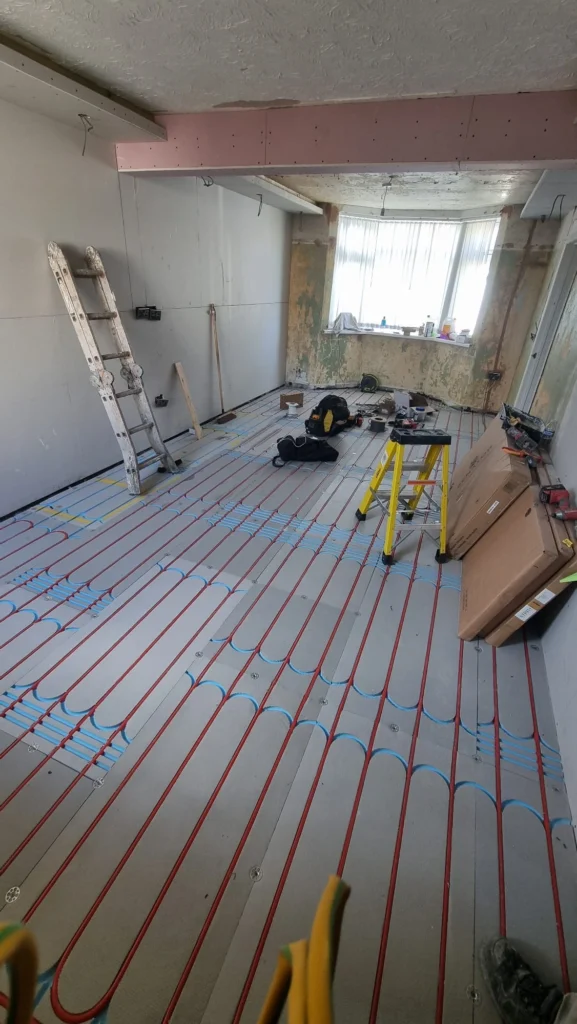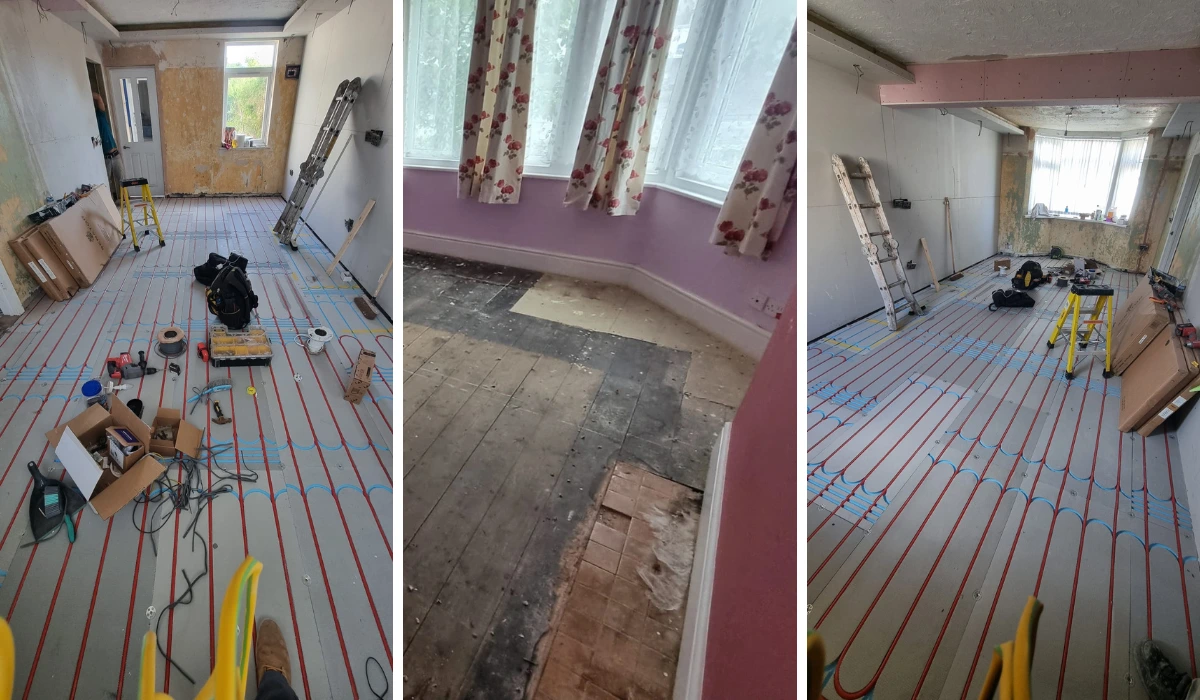Determining which types of underfloor heating are suitable for your home? Choosing the right one is a must if you want to take full advantage of this useful heating technology.
In London, traditional radiators are common almost everywhere. Regardless of having built-in radiators, people are now upgrading their heating systems with underfloor heating. The main reasons behind this revolutionary change are due to energy efficiency and even radiant heat.
So, how do you choose the right one from the different types of underfloor heating? In this expert guide, we will share with you all the necessary details to get started:
What Does Underfloor Heating Mean?
Underfloor heating is a method of heating indoor spaces by circulating warm water through polyethylene (PE) pipes or by using electric heating cables laid beneath the floor surface. This system allows heat to radiate from the floor upwards, creating a comfortable and evenly distributed warmth throughout the room. There are generally two types of underfloor heating systems:
1. Hydronic (water-based) systems, which involve a network of pipes that circulate hot water, typically heated by a boiler or a heat pump.
2. Electric systems, which use electric cables or mats to generate heat when connected to the electrical mains.
How to Choose the Right Types of Underfloor Heating?
Underfloor heating compatibility varies from property to property. A wrong choice can be costly. Below are the factors you need to consider to select the most suitable type for your place:
1. Type of Property
Are you starting from scratch? It can be a new or retrofitted building. Unlike radiators, you can’t install the same type of underfloor heating in all properties.
■ New build property: New builds should install water-based underfloor heating. It heats your home by running hot water through the pipework.
■ Retrofitted property: For a renovation, you should choose the electric underfloor heating. It is easy to install and it runs through the electric mains.
2. Room Size
Depending on your room size, you must decide whether you require hydronic or electric underfloor heating.
Large rooms take a lot of time to get heated. Attaching an electric heating system here will be costly, and you might also face cold spot issues. That’s why you should install a water-based heating system for large rooms. Meanwhile, you can easily install an electric heating system for small rooms such as bathrooms or kitchens.
3. Energy Efficiency
A wet heating system is perfect for your home when you want energy-efficient heating. It reduces running costs and provides even heating.
4. Warm up speed
An electric heating system heats up more quickly than a water heating system. If you want instant heating, an electric underfloor heating system can be your go-to option.
5. Installation cost
If you’re on a tight budget, you might want the most cost-effective installation. Electric heating installation is easy and low-cost, whereas water-based heating systems require a high cost for installation.
6. Running cost
Electric underfloor heating is not the most efficient choice when considering energy costs. This type of system uses a lot of electricity, which might result in higher bills.
For better cost savings, opt for a water-based heating system. If you want to save even more, consider connecting an air source heat pump to the wet heating system.
The Best Underfloor Heating: Wet vs Electric?
Looking for the best types of underfloor heating? Circumstances matter. The best underfloor heating type for you, could be the worst for someone else. It’s all about identifying the most suitable one for you. Here, we will showcase the pros, cons, and installation requirements of hydronic and electric underfloor heating. Let’s make it easy for you to compare.
◼ Wet Heating System(Hydronic/Water-based)
A wet heating system supplies heat through hot water passing through the pipework. It is also called a hydronic system or a water-based heating system. A gas/oil boiler or a heat pump powers it.
Best for: New builds, Large rooms/spaces.
Pros:
- Highly energy efficient.
- Low running cost.
- It supplies even heating and never creates cold-spot or hot-spot issues.
- Keeps the air flow clean from dust as it doesn’t circulate air.
- It comes with a lengthy(50 years) lifespan.
Cons:
- Higher upfront installation cost.
- It doesn’t create too much heat instantly.
Installation Requirements: Since heat pumps connect with boilers or heat pumps, you need a licenced heating engineer to do the installation. It is illegal to go for a DIY approach.
◼ Electric Heating System
An electric/dry heating system creates heat through electric cables or mats. It doesn’t require an additional boiler or heat pump; you just need to connect the heating system to the electric mains. You just need to connect the heating system to the electric mains.
Best for: Retrofits, Small Compact rooms(kitchen, bathroom, etc.).
Pros:
- Easy and quicker to install.
- Low installation cost.
- It can create heat instantly.
Cons:
- Higher running costs.
- The average lifespan(20-30 years) is lower than that of a wet heating system.
Installation Requirements: Unless you have significant expertise in doing electrical work, it’s better to hire a qualified electrician to do the installation work for you.

Why Choose Underfloor Heating?
Traditional radiators have been the default choice for London homeowners for years. However, the best part of a revolution is adapting to new upgrades. Compared to radiators, underfloor heating is 25% more efficient when connected with a boiler and 40% more efficient when connected with a heat pump. Here’s why you should choose underfloor heating over radiators:
✓ Cost-effective:
Water-based underfloor heating supplies heat with the lowest running costs. Especially when it is connected to a heat pump, you can save a lot on running costs.
✓ Even heating:
Unlike radiators, underfloor heating supplies heat evenly. It generates heat all over the floor, which consistently spreads upwards throughout the room.
✓ Good air quality:
Radiators circulate air and may carry dust or allergens, causing poor air quality. Underfloor heating doesn’t circulate air and keeps the air fresh.
✓ Free-up Space:
Unlike radiators, underfloor heating is installed under the floor. It frees up wall space and lowers visual clutter in rooms.
What is the Best Flooring for Underfloor Heating?
Thick or heat-blocking floors can affect the performance of underfloor heating. So you must choose the best floor covering for underfloor heating. Some efficient floorings for underfloor heating are-
Vinyl Flooring: Typical or luxurious vinyl flooring is suitable for underfloor heating. It allows heat to spread upwards. However, check the manufacturer’s recommendations to see if vinyl matches your underfloor heating type.
Stone Tiling: Stone tiles are highly heat conductive and can hold heat for a while. They are considered one of the most efficient floorings for underfloor heating.
Wood Tiling: Wood tiles’ heat conductivity is efficient. Try to use an overlay system and ensure proper insulation. If insulation is lacking, wood tiles may lose heat.
Thin Carpeting: Carpet on the floors is effective for underfloor heating only when you use thin carpets. Thick carpets may lack proper heat conductivity.
How Thick should Your Flooring Screed be?
Underfloor heating performance also depends on the thickness of the flooring screed. Whether you’re housing your pipework or cables under concrete, sand with cement, or a thin layer, know how thick it has to be.
- Concrete Screed: It should be at least 150mm thick. The reaction time is over four hours. If you’re using a concrete slab, keep your heating on always at 15°C or 16°C.
- Sand and Cement Screed: It is typically 65 mm-75 mm thick. Sand and cement screed underfloor heating takes nearly 2 hours to heat or cool the room.
- Thinner Screed: A thinner floor screed is about 35 mm-40 mm thick. You can expect its heat reaction in 40 minutes. Thinner screeds are like a radiator system. They can be used both in a new build and in retrofit flooring.
Final Words
Underfloor heating is one of the best technologies for achieving uniform heat distribution in your space. It can be highly energy-efficient if you choose the right type of underfloor heating system.
However, it’s important to avoid a DIY approach, as this could lead to potential problems and increased costs in the long run. Opting for a professional underfloor heating installer will ensure long-term safety and efficiency.
It’s never too late to upgrade your existing heating system to underfloor heating. Give us a call for installation—you’ll be glad you did!
FAQ:
Which type of underfloor heating is best?
The best type of underfloor heating is wet underfloor heating, especially when connected to an air source heat pump. Contact us to determine the right type of underfloor heating for you.
Which is better, 150W or 200W for underfloor heating?
Underfloor heating requires at least 150W, but the best solution is 200W. Talk to your electrician to adjust the power range.
What is the most energy efficient underfloor heating?
Water-based underfloor heating is the most energy-efficient underfloor heating. It keeps the running costs low.
Does floor heat use a lot of electricity?
Floor heating uses 12 watts per square foot per hour. The electric floor heating typically costs a lot to run.
What is the lifespan of underfloor heating?
Wet underfloor heating has a 50-year lifespan, whereas an electric underfloor heating system has a 20-30 year lifespan.
Does underfloor heating increase property value?
Underfloor heating definitely increases the comfort and value of London homes with radiant warmth. It is designed to be housed beneath the floor, which keeps the home’s outlook minimal and modernistic.



